Card (TCG GB)
A card (Japanese: カード card) is an important component of the video games Pokémon Trading Card Game and Pokémon Trading Card Game 2: The Invasion of Team GR!.
The cards in these video games are based on the real-life Pokémon Trading Card Game. The player is able to collect cards, form one or more decks with them and use them in duels.
Availability
| GB1 | GB2 | |
|---|---|---|
| Pokémon cards | 187 | 381 |
| Trainer cards | 34 | 53 |
| Energy cards | 7 | 11 |
| Total cards | 228 | 445 |
There are 228 cards in the first game (226 normally available and 2 Phantom Cards) and 445 cards in the second game (441 normally available and 4 Phantom Cards). The available cards include Pokémon cards, Trainer cards, and Energy cards.
The current and maximum number of cards is displayed in the Diary and the main menu screen, but each Phantom Card only counts if the player has it. For instance, if the player has all cards except the Phantom Cards in the first game, the number is shown as "226/226". If the player has 99 regular cards and 1 Phantom Card in the first game, the number is shown as "100/227".
All available cards are organized in sets accessible from the computer. For instance, the Colosseum and Evolution sets in the first game, as well as the Beginning Pokémon and Legendary Power sets in the second game. The cards are also organized by type in the Deck screen in both games, the Card screen in the first game, and the Minicom in the second game.
Most of the cards available in both games can be received in booster packs. Some booster packs are given after the player defeats a non-player character in a duel, or receives mail from Dr. Mason. For instance, when the player defeats Brittany in the first game, she gives them two Mystery booster packs. The Promotional Card set in the first game and the Promotion Card set in the second game contain some cards that are given in specific in-game events, such as gifts or in-game trades.
Phantom Cards
- Main article: Phantom Cards
There are 2 Phantom Cards in the first game. In the Game Boy Color release, they may be received exclusively via Card Pop!, a feature in which two players connect to each other via an infrared connection in order to receive cards. However, in the Virtual Console release, the Card Pop! and other multiplayer features were disabled, and the Phantom Cards became unavailable.
There are 4 Phantom Cards in the second game. The two Phantom Cards from the previous game can be purchased from the Game Center, while the other two are exclusively available from Card Pop!.
Pokémon variations
In the first game, there are the Flying Pikachu and Surfing Pikachu. They are unable to evolve. They return in the second game, with the addition of Cool Porygon and Hungry Snorlax.
Dark Pokémon
In the second game, there are 41 Dark Pokémon cards. They are variations of Generation I Pokémon from the Team Rocket expansion, such as Dark Ninetales, Dark Weezing, Dark Persian, etc. (They are not to be confused with the Dark-type Pokémon; this game has no Pokémon of that type.)
- There are no Basic Dark Pokémon cards.
- The Stage 1 Dark Pokémon cards evolve from non-Dark Basic Pokémon cards. For instance, Dark Ivysaur evolves from Bulbasaur, and Dark Haunter evolves from Gastly.
- The Stage 2 Dark Pokémon cards evolve specifically from Dark Stage 1 Pokémon cards. For instance, Dark Venusaur evolves specifically from Dark Ivysaur. Similarly, Dark Gengar evolves specifically from Dark Haunter.
Deck
- Main article: Deck (TCG GB)
A deck is required to have exactly 60 cards, at least 1 of which must be a Basic Pokémon card. There may be up to 4 cards of the same name per deck, except there is no limit for the number of repeated Basic Energy cards in the deck. Different Pokémon cards with the same name count toward the 4-card limit, but variations with different names count as different cards. For instance, the player may have not only four Pikachu cards, but also four Flying Pikachu cards in the same deck.
The player may edit their decks at the Deck screen, from the main menu. Additionally, there are predefined decks from the Auto Deck Machines, and the player may use the Deck Save Machine to save custom decks for later use.
Card sprite
| A holographic Zapdos card, in the first and second games | |
All cards have a 64×48 pixel sprite including a black border with 1 pixel width. The sprites from Pokémon Trading Card Game subtly changed in Pokémon Trading Card Game 2: The Invasion of Team GR!, often with a greater variety of colors in the latter game. In both games, the holographic cards have sparkles as part of their sprite.
Card types
Pokémon card
- Main article: Pokémon (TCG)
Each Pokémon card represents a Pokémon species, such as Bulbasaur, Haunter, Dragonite, etc.
- In the first game, there are 187 Pokémon cards. This includes several cards for the same species, such as multiple Pikachu, Jigglypuff, and Mewtwo cards. These cards represent each of the 151 Generation I Pokémon.
- In the second game, there are 381 Pokémon cards: the 187 from the previous game, plus 194 new ones. Almost all the new Pokémon cards are still for the 151 Generation I Pokémon. The only exceptions are three new Generation II Pokémon cards: Togepi, Marill, and Lugia.
Each Pokémon card has an evolution stage: they are either Basic, Stage 1, or Stage 2. There are seven available Pokémon types: Grass, Fire, Water, Lightning, Fighting, Psychic, and Colorless.
| Pokémon cards (TCG GB1) | ||||
|---|---|---|---|---|
| Basic | Stage 1 | Stage 2 | Total | |
| Grass | 18 | 14 | 8 | 40 |
| Fire | 8 | 8 | 1 | 17 |
| Water | 15 | 14 | 2 | 31 |
| Lightning | 15 | 8 | 0 | 23 |
| Fighting | 12 | 9 | 2 | 23 |
| Psychic | 14 | 5 | 2 | 21 |
| Colorless | 20 | 8 | 4 | 32 |
| Total | 102 | 66 | 19 | 187 |
| Pokémon cards (TCG GB2) | ||||
|---|---|---|---|---|
| Basic | Stage 1 | Stage 2 | Total | |
| Grass | 35 | 31 | 11 | 77 |
| Fire | 18 | 14 | 3 | 35 |
| Water | 32 | 26 | 5 | 63 |
| Lightning | 24 | 15 | 0 | 39 |
| Fighting | 26 | 20 | 5 | 51 |
| Psychic | 26 | 14 | 6 | 46 |
| Colorless | 46 | 18 | 6 | 72 |
| Total | 207 | 138 | 36 | 381 |
Pokémon card information
Main screen
The main screen of a Pokémon card includes various kinds of information.
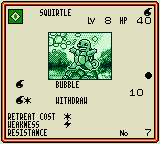
|

|
| Squirtle card (main screen - normal) |
Squirtle card (main screen - duel) |
|---|
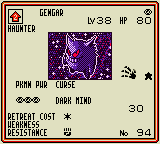
|

|
| Gengar card (main screen - normal) |
Gengar card (main screen - duel) |
|---|
Information found at the top, above the card image:
- The Pokémon's stage symbol:
 (Basic),
(Basic),  (Stage 1), or
(Stage 1), or  (Stage 2).
(Stage 2).
- The Pokémon name, for instance "Pikachu" or "Flying Pikachu".
- The Pokémon's level, for instance "Lv 8".
- The Pokémon's type symbol:
 (Grass),
(Grass),  (Fire),
(Fire),  (Water),
(Water),  (Lightning),
(Lightning),  (Fighting),
(Fighting),  (Psychic), or
(Psychic), or  (Colorless).
(Colorless). - The Pokémon's maxium available HP, for instance "HP 40"
- If the card is seen when it's in the player's party during a duel:
- The placement of the Pokémon in the party is also present: "ACT" (Active Pokémon), "BP1", "BP2", "BP3", "BP4", or "BP5" (each of the five Bench Pokémon).
- The Energy cards attached are shown. The Energy card symbols are the same as the Pokémon type symbols listed above (
 ,
,  ,
,  , etc.), with the addition of
, etc.), with the addition of  (Rainbow) in the second game only.
(Rainbow) in the second game only. - The max HP is not shown anymore as a number. The current HP and damage is shown as a bar made of circles like in the main duel screen. Each circle represents 10 HP. A white circle (
 ) means no damage, while a black circle (
) means no damage, while a black circle ( ) means damage.
) means damage. - The Pokémon's stage symbol becomes a smaller version (also seen in the Pokémon party screen):
 (Basic),
(Basic),  (Stage 1), or
(Stage 1), or  (Stage 2).
(Stage 2). - The previous evolutionary stage is not mentioned.
- The Pokémon's level is located higher and to the right on the screen.
Information found at the side of the card image:
- The symbol of the card's expansion from the real life Trading Card Game, for instance Base Set, Jungle, or Fossil. Base Set cards have no expansion symbol.
- The Pokémon's rarity symbol:
 (Common),
(Common),  (Uncommon), or
(Uncommon), or  (Rare). Some cards have no rarity symbol.
(Rare). Some cards have no rarity symbol.
Information found below the card image:
- The Pokémon's Pokémon Power if applicable. Most Pokémon cards in these games have no Pokémon Power.
- The Pokémon's attacks. In these games, a Pokémon either has one or two attacks. All Pokémon with a Pokémon Power have exactly one attack.
- Each attack's Energy cost.
- The damage dealt by each attack, if applicable. (some attacks don't deal any damage at all)
- A "+" (addition) sign indicates that the damage can be increased. For instance, the power of Blastoise's Hydro Pump's is "40+", because its damage at least 40 and can increase with the addition of more Energy cards.
- A "×" (multiplication) sign indicates that the damage can be multiplied. For instance, the power of Geodude's Stone Barrage is "10×" because it deals 10 damage times the number of heads (in the heads or tails game).
- A "−" (minus) sign indicates that the damage can be decreased. For instance, the power of Machoke's Karate Chop is "50−" because it deals 50 damage minus 10 damage for each damage counter on Machoke.
- The Pokémon's retreat cost (the number of Energy cards that need to be discarded from that Pokémon in order to retreat). Some Pokémon cards have no retreat cost.
- The symbol of the Pokémon's type weakness. Some Pokémon have no weakness.
- The symbol of the Pokémon's type resistance. Some Pokémon have no resistance.
- The Pokémon's National Pokédex number.
Pokémon Power screen
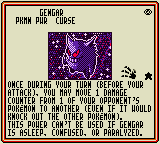
| |
| Gengar card (Pokémon Power screen) | |
|---|---|
This screen describes the Pokémon Power. If the current Pokémon does not have a Pokémon Power, this screen is not shown at all. In normal gameplay, whenever the player places or evolves a Pokémon in the party, this screen is shown automatically if that Pokémon has a Pokémon Power. As an exception, this screen does not not appear when a Pokémon is placed at the start of the game (either on the Arena or the Bench), before the coin is tossed to decide which player plays first.
Like the main screen, it includes the Pokémon's name, image, type symbol, rarity symbol, and expansion symbol. Some components shown in other screens are absent from the Pokémon Power screen, like the Pokémon's HP, level, and stage. Unlike the main screen, the Pokémon Power screen does not change in duels.
Attack screen
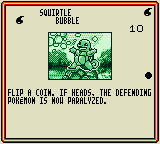
| |
| Squirtle card (Bubble attack) | |
|---|---|
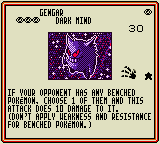
| |
| Gengar card (Dark Mind attack) | |
|---|---|
Each attack of a Pokémon has its own screen (there are either 1 or 2 attacks per Pokémon), with its description, damage dealt, and Energy cards required. Some moves have no description, in which case they only deal damage with no additional effect. Some moves don't display any damage number, indicating they don't deal damage at all.
Like the main screen, it includes the Pokémon's name, type symbol, level, maximum HP, image, rarity symbol, and expansion symbol. The Energy required for the attack is shown where the Pokémon stage would be shown; as a result, the Pokémon stage is not shown in this screen. Unlike the main screen, the attack screen does not change in duels.
Pokédex screen

| |
| Squirtle card (Pokédex screen) | |
|---|---|

| |
| Gengar card (Pokédex screen) | |
|---|---|
The Pokédex screen includes:
- The Pokémon's category, such as "Tiny Turtle Pokémon".
- The Pokémon's height. This is written as "length" in English, like in the real life cards distributed by Wizards of the Coast.
- The Pokémon's weight
- The Pokémon's Pokédex entry.
Like the main screen, it includes the Pokémon's stage symbol (large version), name, type symbol, level, maximum HP, image, rarity symbol, and expansion symbol. Unlike the main screen, the Pokédex screen does not change in duels.
List of Pokémon cards
These are lists of Pokémon cards in the Game Boy games.
- List of Pokémon cards by type (TCG GB1)
- List of Pokémon cards by type (TCG GB2)
- List of Pokémon cards by Pokédex number (TCG GB1)
- List of Pokémon cards by Pokédex number (TCG GB2)
Trainer card
- Main article: Trainer card (TCG)
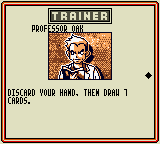
|
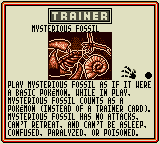
|
| Professor Oak | Mysterious Fossil |
|---|
There are 34 Trainer cards in the first game and 53 in the second game (all cards from the first game return in the second game). Trainer cards provide a supportive role, allowing a player to search through their deck, draw cards, or other special effects.
Trainer cards have a large "Trainer" text at the top. This is followed by the card's name, image, expansion symbol (except for Base Set cards), rarity symbol, and description.
Energy card
- Main article: Energy card (TCG)
In both the first game and the second game, there are six Basic Energy cards:
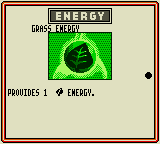
|

|

|
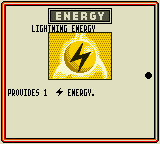
|
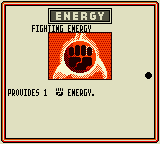
|

|
| Grass Energy | Fire Energy | Water Energy | Lightning Energy | Fighting Energy | Psychic Energy |
|---|
In the first game, there is a single Special Energy card:
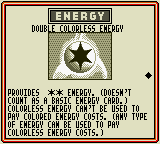
|
| Double Colorless Energy |
|---|
In the second game, there are five Special Energy cards:
Energy cards have a large "Energy" text at the top. This is followed by the card's name, image, expansion symbol (only for the three new Special Energy cards added in the second game), rarity symbol, and description.
See also
- Deck (TCG GB)
- Duel (TCG GB)
- List of card sets (TCG GB)
- List of cards by index number (TCG GB1)
- List of cards by index number (TCG GB2)
- List of Pokémon cards by Pokédex number (TCG GB1)
- List of Pokémon cards by Pokédex number (TCG GB2)
- List of Pokémon cards by type (TCG GB1)
- List of Pokémon cards by type (TCG GB2)
In other languages
| |||||||||

|
This article is part of both Project Sidegames and Project TCG, Bulbapedia projects that, together, aim to write comprehensive articles on TCG-related video games. | 
|
